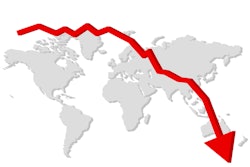
In an election year, especially a presidential election year, congressional and executive branch activity slows down and often comes nearly to a complete stop. This year will be no different, although there are several important food, agriculture, trade and environmental issues that will likely receive significant attention before activity wanes after Memorial Day. These issues include normalizing relations with Cuba, approval of the Trans-Pacific Partnership trade agreement, labeling of bioengineered (otherwise referred to as GMO) food products, precision agriculture, use of drones and implementation of the Food Safety Modernization Act (FSMA).
Low prices and incomes for U.S. agriculture
Commodity prices and incomes for growers and for most agribusinesses along the agriculture/food marketing chain have come down from the highs of several years ago. Commodity markets can of course change very quickly, and unexpectedly, but most observers believe the low prices and low incomes of 2015 will continue in 2016 with no significant recovery, possibly for several years.
Contributing to this is the rapid growth in world production — three years of generally good crops around the world — resulting in growing supplies which have finally caught up and overtaken growth in world demand. Growth in the world economy, particularly in China, is slowing. At the same time the growing strength in the value of the U.S. dollar compared to the value of the currencies of many other countries of the world has made U.S. agricultural products less competitive in world markets.
Key issues with Cuba: Normalization of relations
A little more than a year ago on Dec. 17, 2014, President Obama surprised nearly everyone by announcing the beginning of normalization of relations between Cuba and the United States.
Although there are no immediate prospects that Congress will lift the trade embargo, much has been done by the President, using his executive authority, building upon the trade embargo exception for food, agriculture and medical products approved by Congress in 2001. More than 50 years after Fidel Castro came to power in the Cuban Revolution, embassies have reopened in our respective countries. Travel by Americans to Cuba has been expanded with no specific license required so long as the travel activity fits within 12 broad categories. Direct mail service is being restored, and an aviation agreement allowing daily scheduled flights between the two countries is nearly finalized. The Obama Administration in the months remaining before leaving office will likely keep pushing forward with additional talks including discussions about settling property claims which could help build additional political support for overturning the trade embargo.
Direct banking with Cuba is also now possible. Stonegate Bank in Florida has developed a correspondent banking relationship with a Cuban bank, Banco Internacional de Commercio SA. This means that a U.S. exporter of agricultural products may receive a letter of credit for payment of U.S. goods from the Cuban bank, negotiate the letter of credit through Stonegate Bank in Florida, and receive U.S. dollar payments from the Cuban bank.
For authorized goods, including food and agriculture products, U.S. businesses can now “do business” in Cuba. This will most likely mean that the Cuban government would allow joint ventures with Cuban government-owned businesses. The businesses could hire employees, lease offices, open warehouse and distribution networks, open Cuban bank accounts and other normal business activities. In fact, Sprint and Verizon are now providing mobile phone roaming capabilities in Cuba.
With these recent announcements from the Obama Administration, there is reason for a little more optimism with respect to sales of U.S. commodities to Cuba, and for more optimism for gaining support during the coming months for the eventual lifting of the trade embargo.
Transpacific Partnership Agreement
In early October 2015, the United States and 11 other Pacific Rim nations — Australia, Brunei Darussalam, Canada, Chile, Japan, Malaysia, Mexico, New Zealand, Peru, Singapore and Vietnam — reached final agreement on the landmark Trans-Pacific Partnership (TPP) trade agreement. The TPP is the largest regional trade agreement ever negotiated, comprising nearly 40% of the world’s economy, and accounting for more than 42% of U.S. agricultural exports in 2014. It is projected to increase world incomes over time by billions of dollars, which in turn, will increase the demand for U.S. agricultural products across the board. Importantly, the agreement also includes provisions that will improve sanitary and phyto-sanitary (SPS) measures to help establish and preserve stability in the global trade of commodities and food products.
Japan, one of the largest U.S. agricultural export markets, has agreed to lower or phase out tariffs on most U.S. products. Some highlights include a phaseout of tariffs on most beef products over 16 years. Specifically, on fresh, chilled or frozen beef, tariffs will be phased down from 38.5% to 9% over 16 years. For pork, most tariffs will be phased out over 11 to 16 years, in addition to a reduction in the mandatory gate price specific duty from 482 yen/kg to 50 yen/kg over 11 years. Japan will establish a new duty-free quota for 50,000 tons of U.S. rice, which will grow to 70,000 tons in 13 years. Tariffs on soybean meal of 4.2% will be eliminated immediately. Tariffs on soybean oil as high as 13.2 yen/kg will be eliminated within six years.
Other TPP countries have also agreed to lower or phase out tariffs on most agricultural products. Some highlights include:
- Corn: In Vietnam tariffs as high as 30% will be eliminated in four to seven years.
- Wheat: Tariffs as high as 35% in Vietnam will be eliminated within four years; and all tariffs in Malaysia and Brunei will be eliminated immediately.
- Soybeans: Tariffs as high as 30% in Vietnam will be eliminated within 11 years; and all tariffs will be eliminated immediately in Malaysia and Brunei.
- Rice: Tariffs will be eliminated in Vietnam and Malaysia within eight and 10 years, respectively, and eliminated immediately in Brunei.
The congressional approval process for the TPP agreement is set out in the Trade Promotion Authority (TPA) legislation that Congress passed earlier in 2015. This process requires the President to notify Congress of his intention to sign the agreement at least 90 days before doing so, which he did on Nov. 5. The President could sign the agreement as early as Feb. 3. Once he does, the President must submit to Congress the final text which he and the other TPP countries signed. This must be done 30 days before he submits to Congress a bill to implement (approve) the agreement. The timing for the introduction of the implementing legislation is at the complete discretion of the President. He could try to push Congress to consider the legislation beginning in the spring of 2016, though most signs point to the “lame duck” period following the November 2016 elections as the earliest that Congress will consider the agreement.
Nonetheless, President Obama is expected to continue to make this a priority in his final year in office, and will continue working to secure support for the agreement. Most major U.S. Food and Agricultural trade groups have evaluated the merits of the agreement and have publicly stated their support for early approval by the Congress.
Genetically modified organism (GMO) food labeling
A Vermont law to require mandatory labeling for food products containing GMO ingredients sold within the state takes effect July 1, 2016. Other states in the Northeast have approved similar laws that could take effect if their neighboring states approve mandatory GMO food labeling laws. This threat of a patchwork of state laws on food labeling has caused the food and agriculture industry to ask the Congress to approve legislation to preempt states from labeling GMO containing food products. The House of Representatives has approved a federal preemption, but the Senate so far has been unable to do the same. Time is quickly running out. The Senate is expected to continue its effort to approve a federal preemption early in 2016 to prevent the Vermont law from taking effect.
Precision agriculture and drones
The ability to collect large amounts of agriculture production data; to then analyze the data; and to use the analysis to fine-tune the production process to minimize input use/maximize profit is accelerating rapidly. This is of course good for business and good for the environment.
The use of drones (unmanned aircraft systems) as tools of precision agriculture to gather timely information for crop production holds great promise. Although, the Federal Aviation Administration (FAA) has granted many individual exemptions for agriculture and other industries, the use of drones for commercial applications remains prohibited. An FAA proposed rule which would allow limited commercial use of drones is pending but not yet finalized. It has been expected the rule would be finalized in 2016, but there has been a sharply growing number of reported near misses between drones and piloted aircraft along with more public awareness of privacy concerns. The FAA finalized a rule in December 2015 requiring all drones to be registered so that drone operators causing safety and privacy concerns could be identified by the FAA. Public concerns over safety and privacy may continue to grow, especially if the information obtained by the FAA through the registration rule confirms the public safety and privacy concerns. Any further delay by the FAA in issuing the pending rule allowing the commercial use of drones will delay the expected rapid development of the use of drones in U.S. agriculture.
Food Safety Modernization Act rule implementation
Congressional approval of the Food Safety Modernization Act (FSMA) in late 2010 was the first major rewrite of food safety laws in more than 70 years. It changed the approach from responding to food safety problems to preventing the problems.
The Food and Drug Administr-ation (FDA) has issued five final rules implementing the law, and a sixth final rule on sanitary transportation is set to be finalized in 2016. The rules include; preventive controls for human food; preventive controls for animal feed; the produce safety rule; the third party accreditation rule and the foreign supplier verification rule. The effective date for the rules on preventive controls for human food and livestock feed is generally Nov. 16, 2015, with compliance dates phasing in over several years with the largest companies needing to be in compliance one year after the effective date. The effective date for the produce rule is Jan. 26, 2016, once again with compliance phasing in over several years with the largest firms needing to be in compliance one year after the effective date. In coming months, food, feed and produce companies will need to be making any changes for compliance with these FDA FSMA rules.
Conclusion


















